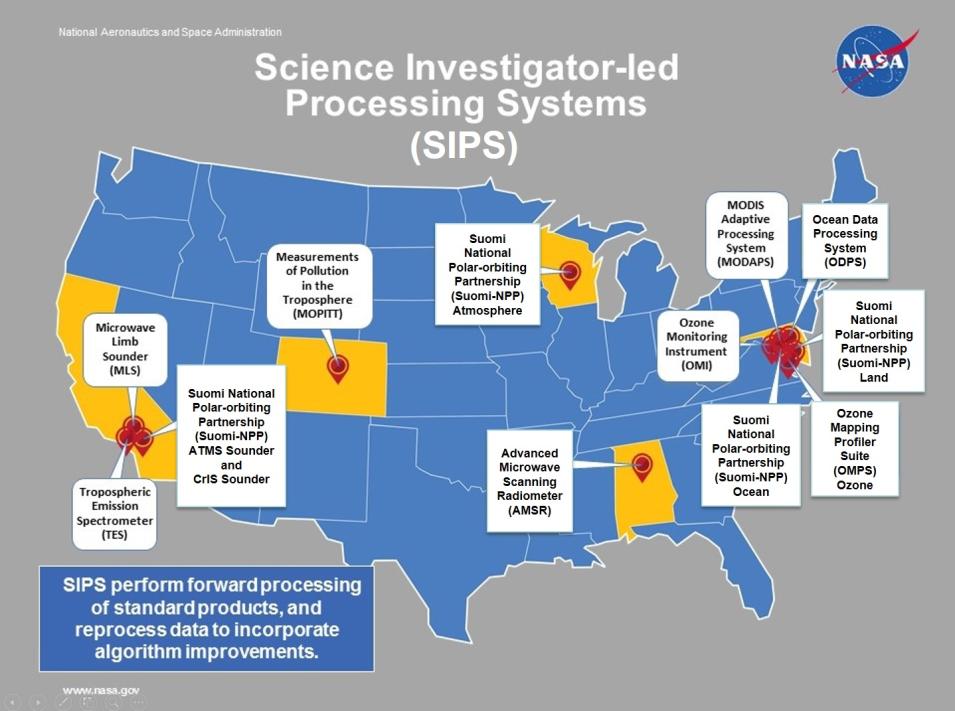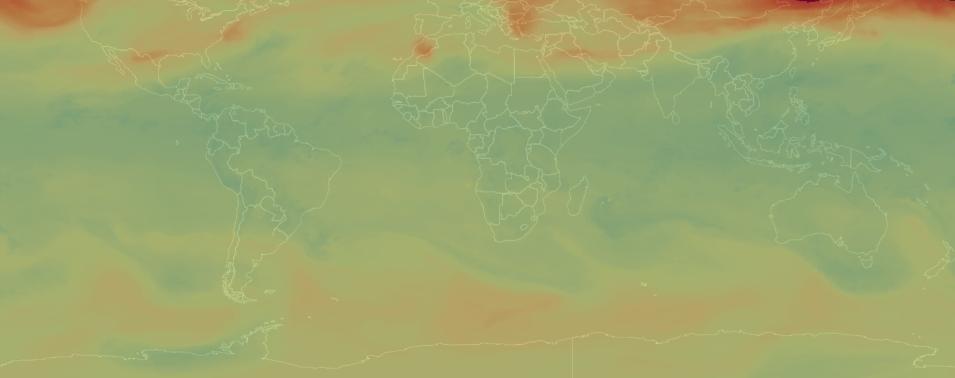OMI is one of four instruments aboard the Aura spacecraft, and is a contribution of the Netherland’s Agency for Aerospace Programs (NIVR, which was merged into the Netherlands Space Office in 2009) in collaboration with the Finnish Meteorological Institute (FMI). OMI uses hyperspectral imaging in a push-broom mode to observe solar backscatter radiation in the visible and ultraviolet electromagnetic spectrums. Earth is viewed in 740 wavelength bands along the satellite track with a swath large enough to provide global coverage in a day with a nominal 13x24 km spatial resolution.
The OMI SIPS began operations in 2004 after the launch of Aura, and currently generates data products including total ozone and other atmospheric parameters related to ozone chemistry and climate. The Royal Netherlands Meteorological Institute (KNMI) provides the instrument calibration software and parameters required to generate the OMI calibrated and geo-located Level 1b products. Algorithms for higher-level OMI products, such as nitrogen dioxide (NO2), sulfur dioxide (SO2), and total column ozone, are provided by OMI science team Principal Investigators.
The OMI SIPS facility consists of the OMI Data Processing System (OMIDAPS), which was originally adapted as a scaled-down version of the processing system that was developed for processing Moderate Resolution Imaging Spectroradiometer (MODIS) data from the Terra and Aqua missions. Rather than use the large, high-performance servers that were required for MODIS processing, OMIDAPS was moved to a cluster of Linux-based commodity computers. A second instance of the OMIDAPS was established for integration and testing of OMI science processes as algorithms are delivered from the science team.
OMIDAPS software originally was developed based on technology prevalent in 2001, using 32 bit Fortran and C computing systems with Hierarchical Data Format-Earth Observing System (HDF-EOS) libraries. The OMI SIPS has continually upgraded versions of the compiler and libraries every few years, making incremental changes to the software.
One of the more significant recent processing challenges faced by the OMI SIPS has been converting all processing code from 32 bit to 64 bit processor systems. This necessitated verifying that existing 32 bit science software would run the 64 bit systems and prioritizing the order in which the science software would be converted. This upgrade also required the conversion of all libraries along with the development of guides for the conversion and documentation of common problems and their solutions. The conversion to 64 bit not only improves the processing capability of the SIPS, it also provides the ability for science algorithms to use larger amounts of memory, access larger files, and use newer hardware instructions.
Most of the OMI processing algorithms also have benefitted from the move to new hardware. In the case of central processing unit (cpu)-bound algorithms, this has resulted in a 50% increase in performance. In addition, the OMI SIPS team has designed the system for rapid algorithm development. This allows a scientist to make a change to their data processing algorithm, test this change, and deliver the updated algorithm to the OMI testing team with one command.
As the OMI science algorithms and knowledge of instrument calibration improve, OMI data products need to be reprocessed. Most recently, the OMI SIPS reprocessed the UV Aerosol data product (OMAERUV) doi:10.5067/Aura/OMI/DATA2004 , OMI/Aura and MODIS/Aqua Merged Aerosol Geo-colocation Product (OMMYDAGEO), and the OMI/Aura Global Ground Pixel Corners product (OMPIXCOR) doi:10.5067/Aura/OMI/DATA2020
OMI SIPS also produces special validation products that are used by the OMI science team and stored at the Aura Validation Data Center (AVDC). Reprocessing of these OMI validation products is required when algorithms or calibration are updated. OMI SIPS recently reprocessed the OMI Above-Clouds Aerosol Data research product that is used for validating above-cloud aerosol data products derived from OMI near-UV observations.
In addition to OMI standard data products, five OMI near real-time (NRT) data products are available through LANCE. The OMI NRT capability is a joint development of NASA and the KNMI.
Since the Aura launch in 2004, over 100 TB of OMI observations have been generated by OMI SIPS and archived in more than 50 standard data products at GES DISC. Each year, approximately 14 TBs of new OMI observations are generated by the SIPS and added to the archive. More than 1 PB of OMI data has been distributed from GES DISC and LANCE over the life of the mission.
Data from the OMPS instrument aboard the joint NASA/NOAA Suomi-NPP satellite (operational 2011 to present) compliment OMI data and enhance the ongoing NASA ozone data record. OMPS measures the global distribution of the total atmospheric ozone column on a daily basis. It also measures the vertical distribution of ozone from about 15 to 60 km/about 9 to 37 miles in the atmosphere, although this measurement is conducted less frequently.
OMPS is a three-part instrument build by Ball Aerospace in Boulder, CO: a nadir mapper that maps global ozone, a nadir profiler that measures the vertical distribution of stratospheric ozone, and a limb profiler that measures ozone in the lower stratosphere and troposphere. The nadir mapper and profiler look directly below the instrument through the atmosphere, while the limb profiler collects data looking through the atmosphere at an angle.
OMPS SIPS began operation with the launch of the Suomi-NPP satellite in 2011, and is responsible for processing and reprocessing Suomi-NPP Nadir Products, including OMPS total column, total column Earth view, total column calibration, nadir profile Earth view, and nadir profile calibration. OMPS SIPS recently established a new processing string to process NOAA-20 OMPS data.


